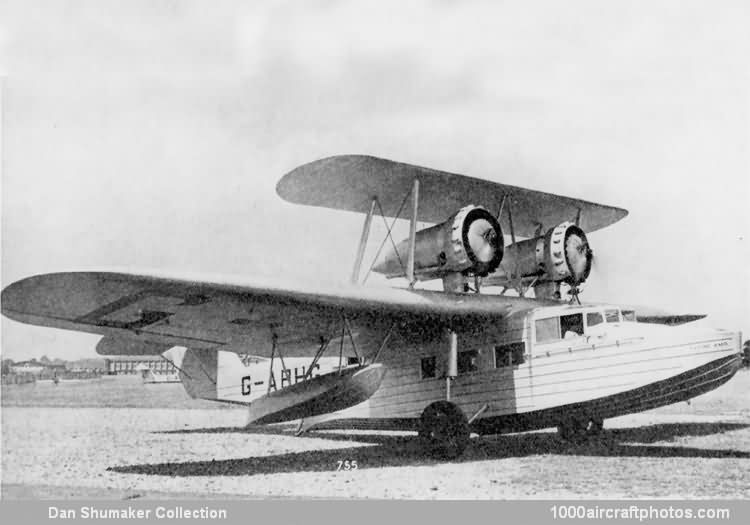02/28/2014. Remarks by Johan Visschedijk: "A scaled-up version of the earlier A.17 Cutty Sark, the Cloud was produced as a civil transport amphibian for two crew and eight passengers. Once again, the pylon-mounted engine installation proved itself capable of the fitment of any air-cooled engine delivering the required horsepower, in this case in the 200-300 hp range.
The Cloud construction was a wood-metal combination, with an Avro-Fokker cantilever wooden watertight mainplane and an all-metal hull utilizing the patent Saunders longitudinal corrugation of the plating first applied to the A.14 Southampton. An enclosed cabin was provided in the bow for the crew, with full dual control, and the passenger cabin lay within the hull, which also incorporated five watertight compartments.
The landing gear consisted of two vertical compression legs, hinged to fold inwards and lift the wheels clear of the waterline, while a combined water rudder/tail skid was attached to the rear step of the hull. The tail unit was of steel tubular construction covered with fabric.
Five aircraft were built:
C/n A.19/1 was the prototype and first flew in July 1930, allotted the 'Class B' marking L-4, later it was reregistered G-ABCJ. Originally it had two 300 hp Wright J-6 Whirlwind engines to facilitate maintenance in Canada, where its purchaser, Captain R. Holt, operated it between December 1931 and January 1934, as CF-ARE.
The machine was then re-purchased by the manufacturers for trial engine installations, and in 1934 it was re-engined with two 340 hp Napier Rapier IV power units and fitted with a small auxiliary airfoil behind and below the engines to smooth out the airflow.
With its original registration G-ABCJ (and new c/n A19/1A), this Cloud was then demonstrated at the Hendon Air Displays of 1934-1935 and after a period of service on loan to Jersey Airways Ltd. was withdrawn from use in December 1936.
C/n A.19/2 was built to the order of A.E. Guinness, it had an unusual feature in that it was powered by three 215 hp Armstrong Siddeley Lynx IVC radial engines with two-bladed propellers. Registered G-ABHG, it was first flown by Squadron Leader L.S. Ash in December 1930. However, the three-engine arrangement had several drawbacks and it was replaced by two 425 hp Pratt and Whitney Wasp C radials with three-bladed propellers before delivery to its owner (who named the aircraft Flying Amo). It was also fitted with an auxiliary airfoil above the engines and twin fins and rudders to reduce landing speed and improve directional stability.
Sold eventually to Imperial Airways Ltd. for crew training in 1940, it was written-off following a crash at Ibsley in June 1941.
C/n A.19/3 was built as a military prototype for pilot and navigator training purposes, serialed K2681 it first flew in 1931. Following service trials, sixteen aircraft were ordered to the Air Ministry Specification 15/32 in late 1932. There were designated A.29 by the manufacturer. Subsequently the prototype was used as a test bed and fitted with a Monospar wing and even later with sponsons.
C/n A.19/4 was of the same configuration as the A.19/1 in original form. Registered G-ABXW, it served on the Glasgow-Belfast route of British Flying Boats Ltd. and with Guernsey Airways Ltd. Operating with the latter company it crashed in the Channel in July 1936, with the loss of all ten occupants aboard.
C/n A.19/5 made its first flight on July 15, 1933, registered G-ACGO. Utilized as a demonstration aircraft, it made an extensive tour of Europe and Scandinavia in the same year, flown by S.D. Scott. On August 5, 1933, it became the first amphibious aircraft to land at Kbely airport near Prague. In 1934 it was sold to CSA (Ceskoslovenské Státni Aerolinie, Czechoslovakia State Airline), the original 340 hp Armstrong Siddeley Serval III engines being replaced by 300 hp Walter Pollux IIR units, the registration becoming OK-BAK.
The aircraft was used until the end of 1938, deregistered on March 31, 1939, and during WW II aircraft was stored in Prague. After the war it was sold and scrapped, however, the fuselage was spared and converted into a houseboat, named Delfin (Dolphin). It was anchored on the Vltava River and later on the Orlik (Eaglet) reservoir, till it was bought by the Military History Institute in November 1975.
In 1977 a long restoration process was started and the fuselage was put on display at the Kbely Air Museum on July 1, 1995."
